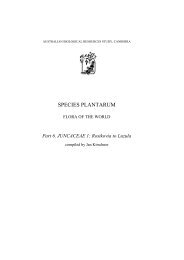Part 7. JUNCACEAE 2: Juncus - Species Plantarum Programme
Part 7. JUNCACEAE 2: Juncus - Species Plantarum Programme
Part 7. JUNCACEAE 2: Juncus - Species Plantarum Programme
You also want an ePaper? Increase the reach of your titles
YUMPU automatically turns print PDFs into web optimized ePapers that Google loves.
38<br />
SPECIES PLANTARUM — FLORA OF THE WORLD (2002)<br />
A very variable species, exhibiting variation in some features ±constant in other taxa (e.g., the<br />
length of rhizome). The characters used for discrimination of the numerous taxa believed to<br />
be distinct from the typical J. capensis (names listed in the above synonymy) mostly concern<br />
the richness and shape of inflorescence, size of flowers and general growth. The common<br />
intermediates between the ecotypic forms and other morphological extremes show that all the<br />
morphotypes belong to a single, variable species.<br />
16. <strong>Juncus</strong> caespiticius E.Mey., in J.G.C.Lehmann, Pl. Preiss. 2: 47 (1846)<br />
T: [Western Australia, Perth, Canning R.] ad fluvium Canning (Perth) novae Hollandiae, 2 Nov 1839, L.Preiss<br />
[Pl. Austral. Occid.] 1733; lecto: W, designated here; iso: BM, BREM, K, L, MEL, NSW, P, W.<br />
<strong>Juncus</strong> similis Buchenau, Krit. Verz. Juncac. 93 (1879). T: [Western Australia] Swan River, J.Drummond 937;<br />
syn: W; 'Australasia S. R.', Hügel; syn: W; [South Australia] Schieckens Schlucht, [H.H.]Behr; syn: W; [South<br />
Australia] Third Ck, Jan 1848, F.Mueller; syn: MEL, P, W; [Tasmania] Van Diemensland, C.Stuart; syn: W.<br />
<strong>Juncus</strong> caespiticius var. bracteatus Buchenau, Bot. Jahrb. Syst. 12: 439 (1890). T: New Zealand,<br />
Stephenson 97; lecto: K, fide E.Edgar, in L.B.Moore & E.Edgar, Fl. New Zealand 2: 68 (1970); iso: W.<br />
Perennials, (5–) 10–55 cm tall, densely caespitose; rhizome short; stolons absent. Stem<br />
smooth, sometimes flowering in the first year and then plants very slender. Leaves basal,<br />
±flat to canaliculate, narrowly linear, c. 5–8 (–15) cm long, usually 1.0–1.2 (–3.5) mm wide,<br />
(to 8 mm wide near base); margins often narrowly hyaline; apex acute to mucronate; auricles<br />
absent. Lower bract 2–11 cm long, narrow, subequalling inflorescence or longer than it.<br />
Inflorescence anthelate or umbelloid, rarely ±congested, of 1–10 (–20) hemispherical to cupshaped<br />
2–10 (–20)-flowered clusters c. 5–7 mm wide. Capitulum bracts ±ovate-lanceolate,<br />
stramineous to castaneous, to c. 2.5 mm long. Tepals ±unequal; outer tepals shorter or<br />
equalling inner ones, lanceolate, carinate, acuminate to acute, 1.5–3.0 mm long, pale<br />
castaneous-brown with paler ±minutely papillose to smooth midrib; inner tepals subobtuse,<br />
±ovate, c. 2.4–3.0 mm long, broadly membranous-bordered. Stamens 6; anthers 0.4–0.8 mm<br />
long; filaments 0.4–0.6 mm long; style 0.2–0.4 mm long; stigmas 0.6–0.8 mm long. Capsule<br />
ovoid to ellipsoid, subacute to ±obtuse, subtrigonous, c. 2.5 mm long, trilocular, smooth,<br />
dark golden brown to red-brown, shorter than or equalling outer tepals. Seeds broadly ovoid,<br />
0.4–0.6 × c. 0.35 mm, pale brown, faintly reticulate; appendages absent. Fig. 51.<br />
Widely distributed in southern Australia and New Zealand. 50: NSW, SOA, TAS, VIC,<br />
WAU. 51: NZN, NZS. In damp, sandy places, often in swampy, brackish ground. Map 194.<br />
50. NEW SOUTH WALES: La Perouse, 16 Mar 1973, L.A.S.Johnson 7603, Jacobs & R.Coveny, (NSW).<br />
SOUTH AUSTRALIA: c. 32 km SE of Mt Gambier, Piccaninnie Ponds Natl Park, Cornwall 153, (AD, NSW).<br />
TASMANIA: Tea Tree Ck swamp, c. 2 km E of Buckland, 14 Dec 1968, Robinson s.n., (HO, NSW255185);<br />
King Island, SE of Dead Sea Lagoon, 4 Mar 1966, J.Willis s.n., (MEL, NSW255186). VICTORIA: Near<br />
Mallacoota aerodrome, R.Melville 2762 & N.A.Wakefield, 9 Jan 1953 (K, NSW); Coimadai Ck, Bacchus<br />
Marsh, Long Forest Flora Reserve, 2 Feb 1991, Stajsic 153, (BRI, HO, MEL, NSW). WESTERN<br />
AUSTRALIA: Ellen Brook, Bullsbrook area, Twin Swamps Wildlife Sanctuary, 28 Dec 1971, N.T.Burbidge<br />
7951, (CANB, NSW). 51. NORTH IS.: Hawera, Taranaki, T.F.Cheeseman 19 (W). SOUTH IS.: S end of<br />
lagoon at mouth of Styx & Waimakariri Rivers, 14 Feb 1966, E.Edgar s.n. (CHR, K, NSW90865); S of<br />
Waimakariri River mouth, 25 May 1960, E.Edgar 7 (CHR, NSW).<br />
New Zealand plants from less wet habitats sometimes have subcongested to almost globular<br />
inflorescences, and were described as var. bracteatus. Western Australian plants often have<br />
small flowers (tepals c. 1.5 mm long) but the plants are still as robust as in eastern Australia.<br />
1<strong>7.</strong> <strong>Juncus</strong> meianthus L.A.S.Johnson ex K.L.Wilson, in J.Kirschner & Z.Kaplan, Taxon<br />
50: 1112 (2001)<br />
<strong>Juncus</strong> gracilis R.Br., Prodr. 259 (1810), nom. illeg., non Roth (1787) nec Sm. (1800) T: ‘M’ [=Ora<br />
Meridionalis]; [Western Australia], King George III's Sound, R.Brown [Bennett 5782]; holo: BM; iso: K.<br />
<strong>Juncus</strong> gracilis var. humilis Benth., Fl. Austral. 7: 125 (1878). T: [Western] Australia, Karri Dale [Karridale],<br />
Dec 1867, P.Walcott; holo: K; iso: MEL.<br />
Perennials, (6–) 10–25 (–30) cm tall, loosely caespitose; rhizome long, ±vertical, distally<br />
±leafy; stolons absent. Leaves basal, 5–18 (–29) cm long, canaliculate but almost terete near












